Cryptozoologist of 2011: Mark Murphy
Posted by: Loren Coleman on December 15th, 2011
Cryptozoologist of 2011: Mark Murphy
by Loren Coleman, Director, International Cryptozoology Museum
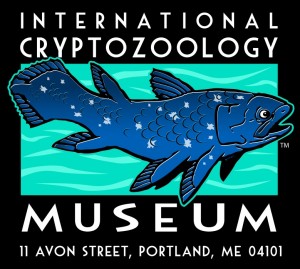
Cryptozoology is the study of unknown or hidden animals. The scope of this science, needless to say, is more than doing fieldwork and finding new species. Sometimes cryptozoology is concerned with recovering records and histories, and therefore takes place among old records, basements, libraries, and archives. This year we celebrate the discoveries of one such cryptozoological figure.
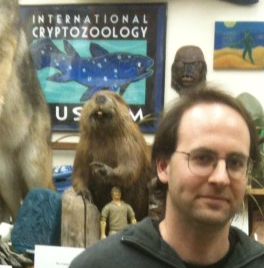
Archive researcher Mark Murphy visits the International Cryptozoology Museum in 2011.
During the late summer of 2011, reports swept through the mainstream media and social media of newly unearthed State Department documents discussing a specific cryptid, the Yeti. The story went viral. The remarkable find made the “Google Editor’s Pick.” One posting told of this as coming “Straight from the National Archives.” The story appears to have broken initially after being highlighted by Paul Bedard and Lauren Fox in U.S. News & World Report on September 2, 2011. It overwhelmed the alternative, web, and other news sources for days, and may be the reason behind some Yeti movies you might see in 2013.
The discovered papers confirmed for the first time the United States government’s belief that the Abominable Snowmen or Yetis roamed the mountains of Nepal in the 1950s, a finding that shocked federal officials “including the archivist who discovered the papers,” noted U.S. News.
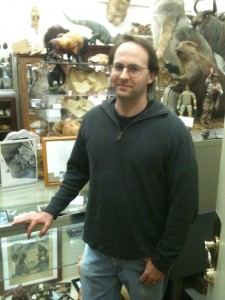
That archivist, Mark Murphy (above), is our “Cryptozoologist Of The Year” for 2011.
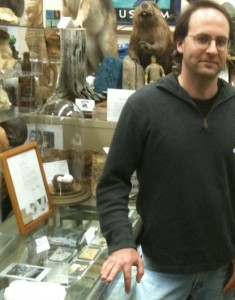
Mark Murphy examines the International Cryptozoology Museum’s Tom Slick expedition materials. Murphy would donate copies of unclassified documents he discovered in the National Archives to the museum.
Long written off as merely an unfounded legend—it was never caught or photographed—the documents provided by the National Archives show that officials in the State Department, Foreign Service, and U.S. Embassy in Kathmandu, Nepal, not only believed in “Yeti,” but endorsed rules for American expeditions to follow when hunting the unknown hairy hominoids down.
“There are, at present, three regulations applicable only to expeditions searching for the Yeti in Nepal. These regulations are to be observed,” said a memo from the embassy written on State Department letterhead.
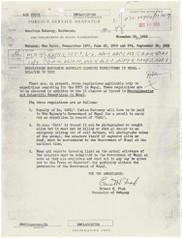
The first rule required that expeditions buy a permit. The second demanded that the beast be photographed or taken alive. “It must not be killed or shot at except in an emergency arising out of self defense,” wrote Embassy Counselor Ernest Fisk on November 30, 1959. And third, any news proving the existence of the Abominable Snowman must be cleared through the Nepalese government which probably wanted to take credit for the discovery.
The closer and closer the archivist looked, he became startled at what he was reading and thus revealing.
Archivist Mark Murphy said he couldn’t believe his eyes when he discovered the long-ignored papers written at the end of the Eisenhower administration. “I thought I was seeing things,” he said. “These documents show that finding the Yeti was a big deal in the 1950s. It goes to show the government was taking this seriously.”
“How seriously?” asked U.S. News & World Report.
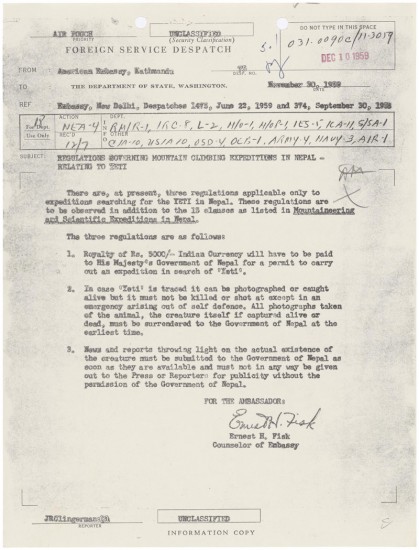
One foreign service dispatch from the Embassy of New Delhi dated April 16, 1959 describes the many American expeditions involved in mountaineering and monster hunting in Nepal.
“American resources in the last two years have been concentrated on efforts to capture the abominable snowman,” the record reads.

Mark Murphy, in conversations with me, told of how he was well-aware of Tom Slick’s expeditions to Nepal, from his earlier reading of my book. He began to put two and two together when he found the documents. He immediately saw the link to what was being said and the Slick expeditions ground-breaking attempts to Nepal to find the Yeti.
Tom Slick, the Howard Hughes of cryptozoology, a Texas oil and beef millionaire, had sponsored, along with F. Kirk Johnson, another Texas millionaire, and the San Antonio Zoological Society, three separate expeditions to eastern Nepal to find the Yetis of the Himalayas and nearby region in 1957, 1958, and 1959.
During 1959, the United States government got interested probably because the Russians and Chinese took a heightened awareness of Slick’s treks to the region. While Slick was sincerely involved in the search for the Snowman, he also had intelligence connections of long-standing. Remember, it was the truly American thing to do back then, and although Slick was an advocate of world peace, he was also a patriot.

Slick’s expeditions found solid physical evidence (e.g. fecal material, hair samples, traditional art, footprints, bones) for the Yeti, but never the final ultimate proof, a body. Instead, Slick turned his support to the pursuit of Bigfoot in California and British Columbia in the Pacific Northwest.
Archivist Mark Murphy shows one of his favorite documents in the film clip, and does appear in and out of the entire four minutes. Murphy reads from the State Department cables containing regulations of the Government of Nepal for expeditions in search of the Yeti, also known as the Abominable Snowman.

+++++++++++++++++++++++++++++++++++
Other Recent Cryptozoologists of the Year:
Cryptozoologist of 2010: Ngwe Lwin
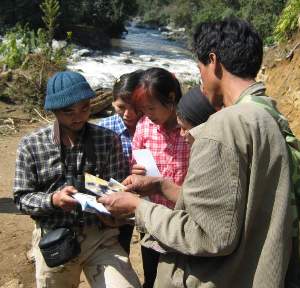
Ngwe Lwin asking local people for information about a little-known new primate species he confirmed as a new discovery. Photo: FFI.
Cryptozoologist of 2009: Gabriele Gentile
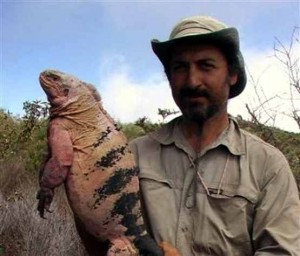
Italian researcher Gabriele Gentile holds a Galápagos iguana, a newly-verified pink and black species he discovered in January 2009. Photo: Gabriele Gentile
Cryptozoologist of 2008: Andrea Marshall

In 2008, after over five years of on-site work and confirming lab findings, doctorate candidate Andrea Marshall identified the giant manta ray as a distinctive new species, separate from the reef manta ray. She may have also found evidence of a future new, third species of manta.
+++++++++
Thank you for your continued support of the International Cryptozoology Museum.

Thank you!
About Loren Coleman
Loren Coleman is one of the world’s leading cryptozoologists, some say “the” leading living cryptozoologist. Certainly, he is acknowledged as the current living American researcher and writer who has most popularized cryptozoology in the late 20th and early 21st centuries.
Starting his fieldwork and investigations in 1960, after traveling and trekking extensively in pursuit of cryptozoological mysteries, Coleman began writing to share his experiences in 1969. An honorary member of Ivan T. Sanderson’s Society for the Investigation of the Unexplained in the 1970s, Coleman has been bestowed with similar honorary memberships of the North Idaho College Cryptozoology Club in 1983, and in subsequent years, that of the British Columbia Scientific Cryptozoology Club, CryptoSafari International, and other international organizations. He was also a Life Member and Benefactor of the International Society of Cryptozoology (now-defunct).
Loren Coleman’s daily blog, as a member of the Cryptomundo Team, served as an ongoing avenue of communication for the ever-growing body of cryptozoo news from 2005 through 2013. He returned as an infrequent contributor beginning Halloween week of 2015.
Coleman is the founder in 2003, and current director of the International Cryptozoology Museum in Portland, Maine.










All this shows is that the government was concerned that expeditions not violate the basic etiquette of diplomacy and international relations.
“Slick’s expeditions found solid physical evidence (e.g. fecal material, hair samples, traditional art, footprints, bones) for the Yeti, but never the final ultimate proof, a body.”
Any followup on the bones? How were the bones proven to be the yetis? Wouldn’t bones have the DNA to prove what they came from? Where are the bones now?
Bootymonster asks a great question. “Where are the bones now?”
We’d ALL like to know that. The rumor, of course, is that the Pangboche Hand was smuggled out of the country in 1959 by actor James Stewart (hidden in a suitcase under his wife’s unmentionables). But he wasn’t the thief…that honor (?) goes to Peter Byrne who wasn’t a thief by nature….let’s just say his enthusiasm got the best of him. OR maybe Peter only stole a small PART of it (as he himself admitted) and it was some mysterious masked figure who stole the whole hand many years later (after Unsolved Mysteries [with Loren Coleman, George Agogino, & Peter Byrne] did a program on it [in 1991]). In any case… the market in illegal antiquities is the place to look.
Now, about the bones. In 1960, Dr. William Charles Osman Hill, the famed primatologist and author of the (not quite completed at the time of his death) 8 volume study Primates: Comparative Anatomy and Taxonomy examined them and said they were from a Neanderthal.
The best Unsolved Mysteries could do [via testing at the Univ. of California – Davis] was conclude that they were “near human” but not human.
http://www.youtube.com/watch?v=FNHKchyL02M
Steven writes: “All this shows is that the government was concerned that expeditions not violate the basic etiquette of diplomacy and international relations.”
Absolutes are dangerous in any sentence.
Actually, that is not “all this shows.”
This posting was about the achievements of a little-known archivist and his remarkable awareness of a discovery he made, cryptozoologically, in the National Archives. This posting was a celebration of that event, and to have this as the first comment about one’s opinion, more or less, dismissing the significance of that finding was, well, unfortunate.
As to what the documents “show,” indeed, it demonstrates more than what seems to be noted in the one sentence left above. China and Russia were concerned with Tom Slick’s expedition spying on them. The US government was concerned about that, and paid attention to the expeditions. The mere fact that the US had something official to say about the Yeti expeditions was an unknown part of history that Mr. Murphy is able to fill in. There is more that can be said about why, when, and what this shows, regarding US federal intelligence services, and foreign service attention to this matter, but then, I’ve said a good deal about this in the new appendix of my revised 2002 book on Tom Slick.
What I also think that this “shows” – and I do mean “this” being how important this new story became over the summer of 2011 – is how important Abominable Snowmen history and research has become in the 21st century. This story and the media interpretation that this “meant” the government took Yeti expeditions seriously, I feel, is worthy of our attention and study.
But bottomline, this posting is about the person of the year in cryptozoology, and our thanks through recognition of this individual’s research and awareness of, in this case, his discovery that made the news in 2011.
Loren, actually I noticed that too and wondered why Steven missed just how IMPORTANT Mark’s work IS. It tells us that (to borrow a phrase from Stanton T. Friedman) the Yeti is a kind of Crypto-Watergate. Our government had reasons for crediting the existence of these creatures (THEN, anyway) and that suggests there is still more to be found out. And we’ll all be benefitting for decades to come from the work of people like Mr. Murphy.
I know I am EXTREMELY grateful to him.
Loren, I did not mean to bunk your post or award, and certainly I do value archival research. I was addressing the meaning of the document itself. Many have taken this as proof of government knowledge and a cover up of crytid hominoids. Surely you are aware of how rampant conspiracy theory is in the bigfooting community. I think it shows only that the government was aware of the expedition, and wished to avoid an international incident or even exposure of intelligence assets.
Yes, Steven, I thought I knew the meaning of your comment, but several misunderstandings could be read into it. I wanted to clear the air about it, and restate the celebratory nature of this award.
BTW, it may not be so clear cut about what was behind the documents.
In documents not specifically shown to the reporters but donated to the ICM collection/exhibition on this matter, Mark Murphy sends along these additional notes: “I thought you might also like copies of two Department of State documents (Outgoing Telegram 1084 and Incoming Telegraph 1108) that were in the same folder with the other documents and which both reference Tom Slick. I found the last paragraph in Telegram 1108 interesting when it states from Peter Byrne that Tom Slick was not planning to sponsor another expedition in 1959 until he was told by the Russians that they were considering a large expedition to search for the Yeti in the summer of that year. It is amusing they would tell him this since they had accused him of using his expeditions to spy on the Chinese as indicated in The New York Times article on April 27, 1957.”
The Chinese activities in regard to Tibet and its subsequent invasion were surely more pressing a concern to the US Government and CIA than the existence of the hairy hominoid they perhaps partially used as cover for their operations.
Many in the Bigfooting world make the mistake of taking any governmental mention of Bigfoot as proof that they “KNOW” about it and are covering it up somehow. Look at the Washington State Environmental Atlas, done for the Army Corps of Engineers. Just the depiction of a Sasquatch along with other fauna like orca is enough for some like Paulides to state that this is an official endorsement of the existence of the creature. In fact, the Atlas was made mainly for popular consumption, and its feature on Sasquatch was a big “what if” veering toward the description of popular legend. The Skamania ordinance against Bigfoot hunting is another clear example, enacted on April Fools Day, of a law meant to quell turkey shoots seeking Bigfoot glory that could endanger actual known hominids: humans. Again, this is not an official announcement that Bigfoot is real by “The Government.” Also, there are endless stories of black helicopters and vans collecting Bigfoot corpses and such, but not an ounce of real documentations. Real conspiracies eventually leak, as humans talk. False conspiracies are the ones that never leak. The case of a perfect, air-tight conspiracy or cover-up is, I’m sure, exceedingly rare.
For Steven Streufert:
“The second demanded that the beast be photographed or taken alive. “It must not be killed or shot at except in an emergency arising out of self defense,” wrote Embassy Counselor Ernest Fisk on November 30, 1959.”
I’d say that points to a weetad more than just pro forma protocol. Which could be stated in very generic terms regarding biological specimens. The which were being killed, left and right, for decades after Fisk’s missive, with mumness the response from the State Department. That quite indicates a very specific response, tailored to a very specific case.
Read Loren’s book the cover of which is up there, and one sees that there was enough connecting-dots done before the Slick expeditions for any thinking person in touch with the evidence to consider it possible that Slick would come back with something, and to make it imperative that it be specified in what condition that very specific something be brought back.
There’s no coverup at all being alleged here. Just a memo. Filed, note; ON file, in OFFICIAL read PUBLIC FILES, and not burned, eaten, or stashed in a Yeti carcass that was then tossed in a cave and obliterated with high explosive. The memo is PUBLIC information; it’s how this guy got it. One could consider it reasonable that the Government might not want to come off as a bunch of woowoo Yeti Believers, so they were being discreet, and coming slightly short of issuing a presidential proclamation of World Yeti Day. (It’s called the “diplomatic corps” for a reason.) But they were just as clearly not overly concerned that the memo might be leaked; and the memo is appropriately provisional, i.e., IF you find something… .
And I would argue with you to boot that the Washington Environmental Atlas entry does not veer one iota toward the “legend” finding, any more than it veers toward the real-animal finding, as a not-too-careful reading would make clear, and a careful one even more clear. It’s open-minded, leaving the resolution up to time and evidence. It would have been very simple for them to leave the sasquatch out of the Atlas, wouldn’t it?
Yes. It WOULD have.
There is no need to grasp at every single bingle gingle straw to maintain a skeptical attitude toward evidence.
Did I say that I thought there was a government cover up? No.
The point I made is that the memo simply seeks to avoid an international incident, either over potential wildlife issues or diplomatic ones. Clearly, the government where such a creature were captured would want to keep it, not have someone steal it away. That is the potential problem.
The WA Atlas has a cartoon at the bottom of the page saying, “Mythical creatures shouldn’t be mentioned in the atlas!” The entry starts by saying the very existence of Sasquatch is disputed, and ends by saying if the creature is purely legendary the legend is sure to be a long time dying. You tell me that sounds like an official recognition?
“Legendary or actual, Sasquatch excites a great popular interest in Washington.”
That is the concluding sentence. Think again.
Stop attacking straw men.
“Stop attacking straw men.”
But isn’t that what we’re asking you to do?
You talk about conspiracy theory among Bigfooters. That’s attacking a straw man. Does Jeff Meldrum say anything about that? John Bindernagel? Is that part of the official position of the TBRC or the BFRO? No. But fringe Bigfooters spout that crap…and fringe ‘skeptics’ attack it, because they can’t address the scientists on their ground. Did it occur that there’s a scientific core to the proponent position that the skeptic position lacks, and that that scientific core tends not to give the fringe the time of day?
If you’re going to take the proponents to task, it’s the scientists you should be addressing, not the woowoos. They say you’re wrong, and they have decades of training backing them up. Your move.
Another fringe skeptical tactic is to bring up …well, as I said, to grasp at any straw that might offer some hope that they’re right. Examples:
1. The WA Atlas has a cartoon at the bottom of the page saying, “Mythical creatures shouldn’t be mentioned in the atlas!”
IT’S A CARTOON. And given the lampooning function cartoons frequently play, it could just as easily be interpreted as: “Our ignorant brass thinks this critter isn’t real!” It wouldn’t be the first time clever underlings used their superiors’ ignorance to slide in a dig right uinder their noses. I choose to simply see it as the tongue-in-cheek anyone would employ if constrained to mention something that isn’t proven yet. The great point to be made by the inclusion of the sasquatch is that it embodies, you can bet on this, an official position: We don’t know. But no objective read of it could come down on either side of that line.
2. “The entry starts by saying the very existence of Sasquatch is disputed”
….which is, um, a fact, right? What point is being made there? I’d say: the very point the words make: We don’t know. Which fringe skeptics read as: we shouldn’t even be looking. Which truly curious people, i.e., those with a scientific bent, would read as: we should find out. Right?
3. “,,,and ends by saying if the creature is purely legendary the legend is sure to be a long time dying. You tell me that sounds like an official recognition?”
Yet another fringe-skeptical tactic: interpreting uncertainty as recognition, and questioning as answering. You should know that many on the skeptic fringe who have posted here view me as a proponent, when in fact I embody what skeptics SHOULD be: people who question every unsubstantiated assumption, including the one that we should all just go back to sleep because this just ain’t real. Someday I’ll figure out what’s behind that. It just seems silly.
Did I say it was officially recognized? No. I didn’t even imply it. But it’s pretty obvious, by the simple inclusion of the animal and the most cursory read of the entry, that there is an official position in that document on the sasquatch:
We don’t know.
Which anyone with a true scientific bent would take as:
We should find out.
Right?
Steven Streufert:
I forgot to mention one more skeptic-fringe tactic:
To sort-of-allege something (Bigfooters see a coverup behind every bush), then deny you were alleging it. Politicians might call it “dog-whistle skepticism.”
Remember: I never said that you personally alleged a coverup. I responded to your assertion that Bigfooters do it. Fringe ones? Yes. Serious ones? No. This issue can be resolved by simply not listening to the fringe – why ever? – and focus the skepticism on the science of the proponents. Something, BTW, that I have never seen successfully attempted, much less done.
Murphy never said there was a government coverup. He simply unearthed a document that indicated serious government interest in the topic. That says nothing about a coverup either way.
But it does show something that should give the skeptical community significant pause. Because in any decade, the government has a lot more resources than the skeptical community does.
DWA, you seem to have mistaken my position.
I am a skeptical proponent.
I am mainly skeptical of humans, not so much of Bigfoot.
I am skeptical of human thought and belief systems.
It isn’t just “fringe” people buying into the conspiracy theory model in Bigfooting. It is ALL OVER THE PLACE. It includes people like Paulides (NABS), whom I’m sure most would consider mainstream and notable enough.
I am fully aware of the scientists in the field. In fact, I talk to them regularly. Have you ever even seen the work I do? I suppose not, as you don’t even seem to know my position.
I stand against unreasonable thought and false assumptions, as well as ridiculous claims. This memo is interesting, but it does not prove any government knowledge of said creatures. The WA State Atlas was made for popular consumption, and it makes that rather clear in the last line of the article. Sasquatch is included for its CULTURAL relevance in Washington State, not because the government knows anything more about it or is looking into the subject in any way.
If you wish to contact me and actually find out what I think you are welcome to do so here.
Best, Steve
Steven,
Maybe I don’t know your position. But I was having problems with your treatment of two incidents that just say this to me and, really, no more:
1. The US government was interested in the yeti in the 1950s.
2. The USACOE considers the sasquatch debate open.
That’s all.
Believe me, if you’re skeptical of human belief systems, there’s nothing like the search for hairy hominoids to give that skepticism all the work it can handle. I promise not to start in on it here; not only am I all over Cryptomundo on it, but sounds like you’ve been there, maybe much more than me.
And I may just drop in there soon.
The Atlas is not an “official” statement of the Army or the government, and in fact was written on contract by a biologist writer for the largely civilian Corps of Engineers. This is my understanding, and it is clear in the pages I have seen from the Atlas. I’ve never seen the whole book, but it does not appear to have anything other than a popular function.
The one memo does not indicate any larger interest in the government in Yetis. It only shows that they were aware of an effort to find one by American nationals who would be operating in a very sensitive diplomatic zone. Surely some cryptid primate had very little importance for them when compared to the idea of international conflict with the invading Chinese.
Parsimony is always better than Conspiracy Theory, save if they really are out to get you. Even then, it is best not to draw lines between dots when there is no other supporting evidence for that line. Doing so can easily lead to the wrong picture in one’s understanding.